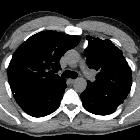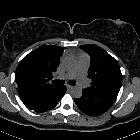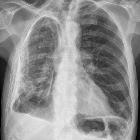talc pleurodesis




Talc pleurodesis is one of the chemical methods of pleurodesis which is a procedure performed to prevent recurrence of a pneumothorax or recurrent pleural effusion in benign or malignant conditions. It involves achieving an area of adhesion between the parietal and visceral layers of the pleura.
Radiographic features
CT
After talc pleurodesis, the pleural space can reveal variable degrees of pleural thickening (can be nodular and or linear), often with a residual loculated effusion. Pleural calcification can also occur. The changes are usually stable on serial imaging . Pleural thickening usually affects the posterior basal pleura or apices but can extend into the fissures.
FDG-PET
Talc deposits produce areas of highly increased 18F-FDG uptake. Since talc is not metabolized by the body, the FDG-PET scan can show high uptake and remain positive, most likely as a result of a foreign-body granulomatous reaction. These changes can persist for many years.
Siehe auch:
und weiter:

 Assoziationen und Differentialdiagnosen zu Pleurodese:
Assoziationen und Differentialdiagnosen zu Pleurodese:
